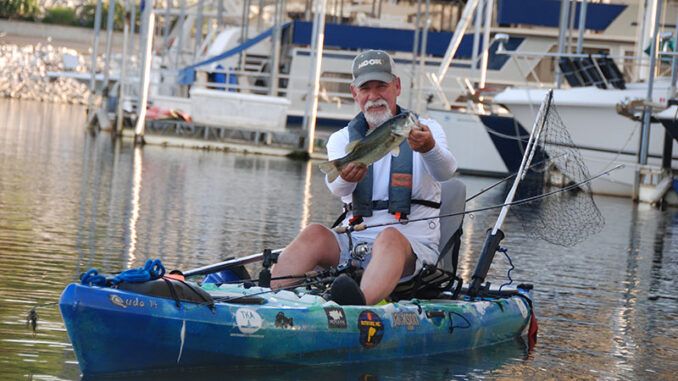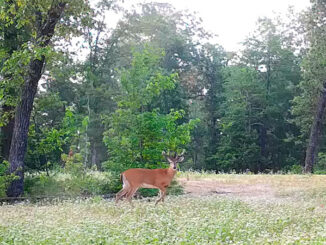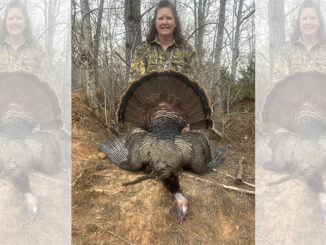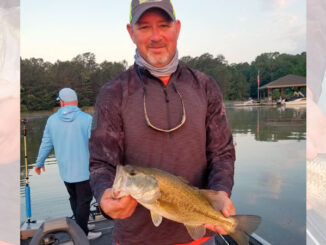
When it comes to grabbing the attention of a pre-spawn or spawning bass that’s dead set on seeking out and protecting a stretch of underwater real estate, it’s hard to beat a wacky rigged worm. The wacky rig is a favorite go-to technique for many professional and weekend anglers during the pre- and spawning seasons. Worms top the list of baits to fish wacky-style, and the hook can be singularly impaled through the middle of the bait or double hooked, meaning the bait is hooked down through the middle then turned and hooked again coming back out.
Another alternative is to use a specially made O-ring that encircles the bait, then the hook bend is slipped under the ring rather than the bait.
The single hook results in more lively action of the bait, but the bait will only last for one or two fish, resulting in cycling through a lot of plastic baits. The O-ring tends to reduce the damage to the bait while at the same time imparting the same action of the single hook.
Another worm rigging option that has taken a back seat to more popular set-ups is the Texas rigged soft plastic.
Texas rigging allows the angler to precisely position the bait anywhere, especially in dense vegetation or heavy cover. The Texas rig can be used on virtually any plastic bait with emphasis on being able to firmly hide the hook point in the bait while allowing for maximum hook penetration when a bass latches on to the bait.
The hookset
To ensure a good hookset, push the hook point all the way through the bait, creating a channel in the plastic, then pull the hook point back far enough to cover the point.
Similarly rigged to the Texas rig, placement of the weight on the Carolina rig should reflect the terrain the angler is fishing. The idea is to allow the weight to maintain contact with the bottom while the bait moves relatively free behind the weight.
When fishing submerged vegetation, adjust the leader length so that the bait will be visible at the tops of the grass while the weight bounces along the bottom, but remember, the longer the leader, the more lifelike your bait will appear.
When setting the hook on a Carolina-rigged bait, be sure to reel in the slack and feel the fish on the line before striking back. Having slack in the line on the hookset is the most common cause of missed hooksets.
Don’t overlook bass in small places
Every spring, kayak anglers prep their boats and gear, getting ready for spring bass fishing. Unfortunately, when it’s time to launch the boat, it often means competing with larger power boats for fish on large public impoundments that already see fishing pressure seven days a week during the spring months.
Smaller bodies of water have become popular with kayak anglers. State lakes and county parks often offer fishing ponds to the public that rarely see a boat launched into their waters.Other locations include private water bodies that are only fished by a few individuals or maybe not fished at all. These locations usually fly under the radar, but with the information available on the internet today, getting access to unfished waters is easier than ever.
The first is the availability of satellite images and mapping. Google Earth, Zoom Earth, Earth Explorer are just a few of the resources available to take a look around you and find fishable water. These websites and services will show you landmarks, public roads, accessways and to a certain degree, give you an idea of the depth of these waters.
The next hurdle is landowner permission, either to cross private land in order to launch in a public stretch of water or permission to fish a private pond or other impoundment. Fortunately, finding out the registered owner of the land is much easier with public GIS and tax maps by county also online and at your fingertips.
Seeking permission to access private land or water has not gotten easier over the years, partially due to the ease of knowledge described above, but also for fear by the landowner of liability risks should an accident occur while you are on the property.
When seeking permission for land or water use, the direct, approach is always best. You could start with a phone call and follow up with an in-person meeting. Explain your intentions for use of the land and or water. Explaining your willingness to help manage the property, either by cleaning up or helping to remove certain species or sizes of fish if the pond is being managed.
If the landowner is reluctant to give you permission, you can alleviate some of the fear by showing proof of liability insurance. Coverages are often attached to standard homeowners policies or some insurance carriers offer a stand-alone liability policy designed to protect the landowner from incidents that occur on the property.
Educate yourself on the science of farm pond fisheries management and offer to start or assist the landowner with such a project. This is likely to entail a fair amount of work, but the return would be a largely untapped fishing resource.
The end goal is to establish a rapport and trust with the landowner that benefits both parties.





Be the first to comment